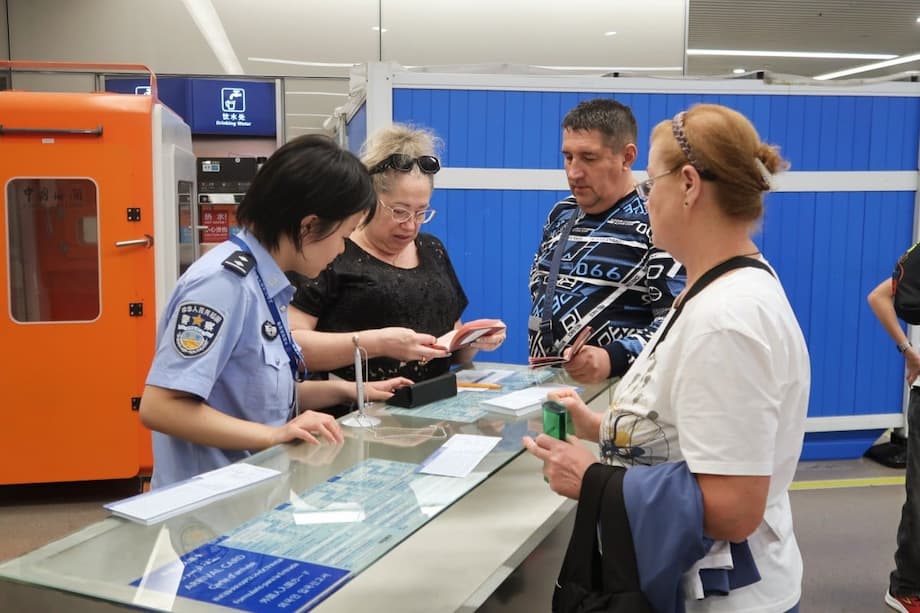Visa free access reshapes the global map of Chinese cities
China’s push to welcome more visitors without visas is reshaping how its cities compete on the world stage. A new edition of the International Exchange Centres Index, produced by Tsinghua University’s China Institute for Development Planning with Deloitte China, shows Beijing climbing to sixth place worldwide and Shanghai rising to eighth. The study cites a surge in inbound visitors using visa free entry, stronger transport connectivity, and improved digital convenience for travelers. London, Paris and New York remain the top three, but Beijing’s momentum and Shanghai’s renewed draw point to a broader rebound in people flows that cities rely on for business, research, and tourism.
- Visa free access reshapes the global map of Chinese cities
- What is behind the rankings move?
- How visa free entry changed travel flows
- Airlines and airports ride the upswing
- Tourism spending and local service upgrades
- Beyond megacities: Chengdu, Jinan and Xiamen
- How city tier dynamics shape competition
- Challenges that could cap the gains
- Why global city standing matters
- Key Points
Shanghai recorded 2.6 million overseas visits in the first half of 2025, a rise of 44.8 percent year on year, and about 1.4 million of those travelers entered under visa free arrangements. Shanghai Pudong International Airport handled 2.37 million entries from overseas, the highest in the country during that period. Beijing welcomed 1.49 million overseas entries in the first half, double the previous year’s level, with more than 840,000 using visa free entry. The report also emphasizes advances in science and technology and deeper international connectivity, which together are reinforcing the role of both cities as hubs for investment, academic exchange, and events.
What is behind the rankings move?
The International Exchange Centres Index looks at factors such as international influence, exchange activity, connectivity and openness. The 2025 results show a mixed picture across Greater China. Hong Kong placed seventh, down from fourth, after the authors excluded inbound tourist data from mainland China in the latest edition and amid disruptions to global trade. That adjustment changed the way cross boundary travel flows were reflected in the index. The top three of London, Paris and New York did not change, underlining that a comprehensive ecosystem of finance, culture and talent still anchors the very top tier of global cities.
Research strength and innovation also helped lift China’s leading cities. Over the past decade, Shanghai ranked second worldwide for the number of scientific and technological publications, behind only Beijing. Shanghai also placed fifth among the sampled cities for the number of unicorn companies, privately held firms valued at 1 billion dollars or more. These metrics show how academic output and entrepreneurship feed into rankings that track international exchange, since they correlate with conferences, cross border investment, and high skill travel.
How visa free entry changed travel flows
Expanded visa free entry has shifted patterns of who comes to China and how often. From January to August 2025, the National Immigration Administration reported 15.89 million visa free entries by foreign nationals, a rise of 52.1 percent year on year. During the same period, border inspection agencies processed 51.27 million foreigner entries and exits, up 27.8 percent, and visa free arrivals accounted for about 62 percent of all entries. In total, China recorded 460 million inbound and outbound movements across all travelers, a 14.9 percent increase compared with the previous year. Immigration authorities say they have streamlined procedures and staffed more inspection channels to keep clearance times efficient amid the rebound.
Visitors from Southeast Asia have powered much of the growth. Nationals from ASEAN countries made more than 9 million visa free trips to China in the first eight months of the year. A reciprocal visa free agreement with Malaysia took effect on July 17, and Malaysian passport holders made 180,000 trips to China shortly afterward, about 150,000 of them visa free. These outcomes show how reciprocal agreements can quickly unlock demand, while unilateral visa free measures also bring in travelers who are testing routes and experiences that were harder to arrange just a few years ago.
Russia has emerged as another strong source market. China began a test period allowing Russian citizens with ordinary passports to stay up to 30 days without a visa for tourism, business, family visits, cultural travel and transit. Flight search interest from Moscow to Chinese cities jumped immediately after the announcement. During the summer season, bookings from Russia to China grew sharply, led by Beijing, Shanghai, Sanya, Guangzhou and Harbin. Hainan province, which already permits 30 day visa free entry for citizens of 59 countries, recorded 663,000 foreign entries and exits in the first half, with 89 percent under the visa free scheme.
Airlines and airports ride the upswing
International aviation and major airports are responding to the influx. Shanghai Pudong’s leading count of overseas entries reflects both restored route networks and the draw of a city that blends finance, culture and technology. Carriers serving China are putting more capacity on routes that connect into the country’s biggest gateways and into popular vacation spots like Hainan.
Singapore Airlines describes the Chinese mainland as a top strategic priority. The carrier is increasing capacity on city pairs that are seeing sustained demand and working more closely with Chinese partners to widen choices for travelers. The company’s senior vice president for marketing planning, Dai Haoyu, framed the long term plan plainly.
Over the next 10 to 20 years, we aim to continuously expand our route network in China by adding more destinations.
The airline has code sharing arrangements with Chinese partners and plans aircraft upgrades on parts of its fleet. Those steps, combined with a larger pool of visa free travelers, widen the funnel for tourism and business travel into cities that benefit from the index’s visibility.
Tourism spending and local service upgrades
Local governments and businesses are adapting services to capture more spending from newcomers. Sanya in Hainan has expanded Russian language signage at airports, key attractions and shopping districts. Hotels report sharp growth in Russian bookings, and many have added staff who speak Russian, upgraded dining options, and created family packages. Wuzhizhou Island has increased multilingual information and plans more interactive experiences tailored to visitor preferences. These changes address practical hurdles for first time visitors such as language gaps, activity guidance and payment familiarity.
Payment and logistics are also improving for international guests. Foreign bank cards can be linked to widely used mobile payment apps for small purchases, and more merchants accept international cards or offer simple cash exchange. Hainan’s long running visa free entry policy has made the province a test bed for visitor services, which helps explain why such a high share of arrivals there are visa free. The result is a clearer path from policy to spending, felt by hotels, transport operators, attractions and retailers.
Beyond megacities: Chengdu, Jinan and Xiamen
Rising demand is not limited to Beijing and Shanghai. Chengdu reported 287,000 visa free entries in the first half of 2025, up 120 percent from a year earlier. The city’s tourism mix, from culinary culture to the giant panda research base, is connecting with better international access. New and restored international flights, along with visa free eligibility for more nationalities, are bringing travelers who then distribute across western China.
In Shandong province, Jinan has become a popular check in city under the 240 hour transit visa free policy and the broader expansion of visa free arrangements. Most foreign visitors currently come from Japan and South Korea for sightseeing or business. The city expects ongoing growth as more travelers select itineraries that begin in secondary hubs rather than the traditional gateways.
There is also evidence that smaller coastal cities are climbing in long running global rankings. Xiamen entered the Globalization and World Cities 2024 list at 83rd, its first appearance in the top 100 after a dozen years of steady progress. That research evaluates cities through an economic and services lens, which differs from exchange and connectivity indexes. Together, these rankings underline that multiple Chinese cities are tightening their links to global networks of production, services and travel.
How city tier dynamics shape competition
Businesses often segment China by city tier to guide investment decisions. Tier 1 cities such as Beijing and Shanghai are large, wealthy and well connected. Tier 2 and Tier 3 cities have lower costs and faster growth in many consumer sectors, along with more headroom to attract new services and events. Visa free entry reshapes these calculations by lowering planning friction for international teams that want to run roadshows, attend trade fairs or scout suppliers beyond the largest hubs.
Inbound travel still concentrates in the biggest markets because they offer dense clusters of hotels, meeting venues and international schools, along with deep talent pools. Yet as visa free access and transit options expand, the perceived risk of adding a secondary stop on an itinerary falls. That change supports a wider distribution of benefits from inbound tourism and business travel, which can accelerate the rise of fast growing cities in national rankings and in specialized global lists.
Challenges that could cap the gains
A few bottlenecks could slow growth if left unaddressed. Travelers still report uneven acceptance of international cards among small merchants, although linkages to popular mobile wallets are helping. Mobile data access and SIM card setup can be confusing on arrival, especially for older travelers. Language support is improving in transport hubs and at major attractions, yet remains limited in some smaller venues. Officials say they are adding inspection staff at peak times and keeping more passport control channels open to shorten queues as entries rise.
Rankings also respond to technical choices made by their authors. Hong Kong’s drop to seventh in the exchange index reflects a change in how inbound flows are counted and ongoing pressures tied to weaker global trade. External headwinds in shipping and manufacturing can depress cargo throughput and business travel, which then echo through a city’s score. Policymakers and business groups will need to keep a focus on the practical experience of travelers if they want gains in openness to translate into durable rankings strength.
Why global city standing matters
Global city status is not an abstract label. It reflects the density of people, firms and ideas that meet and mix in a place. Beijing’s research concentration anchors conferences and cross border academic partnerships. Shanghai’s strengths in finance and technology support dealmaking, product launches and specialist talent flows. Visa free entry multiplies those encounters. When it becomes easier to attend a trade show, visit a lab or scout a partnership, more of those trips happen. That is why ease of entry is factoring into how rankings assess exchange and connectivity.
Longer visa free stays also matter. A 30 day window gives travelers time to see more than one city, meet customers outside the traditional hubs, and extend a stay for leisure. Improvements in digital payments and transit coordination make those multi city visits simpler to plan. These ingredients, coupled with rising output in science and entrepreneurship, explain why Beijing and Shanghai have gained ground this year, even as London, Paris and New York hold their lead.
Key Points
- Beijing rose to sixth and Shanghai to eighth in the 2025 International Exchange Centres Index.
- London, Paris and New York remain the top three in the global exchange and connectivity ranking.
- Hong Kong dropped to seventh after the index excluded inbound tourist data from mainland China and amid trade pressures.
- From January to August 2025 there were 15.89 million visa free entries by foreign nationals, up 52.1 percent year on year.
- Visa free arrivals made up about 62 percent of foreign entries in the first eight months of 2025.
- Shanghai saw 2.6 million overseas visits in the first half of 2025, with about 1.4 million visa free entries.
- Travelers from Southeast Asia accounted for a large share of visa free growth, aided by a reciprocal arrangement with Malaysia.
- A pilot program allows Russians to stay up to 30 days without a visa, and Hainan reports that 89 percent of its foreign entries are visa free.
- Shanghai ranks second globally for scientific and technological publications over the last decade, behind Beijing, and fifth for unicorn companies among sampled cities.




